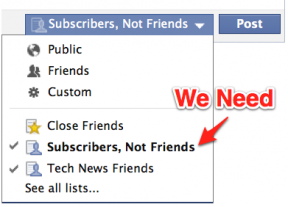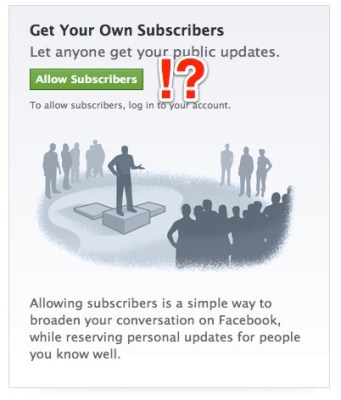I’ve been using Facebook since its early years. So today it has the most complete and accurate set of connections to people I’ve known throughout my life. Exactly because of its success in assembling this group, I’ve avoided turning on its five month-old Subscribe feature — until now.
For those of you who want to gain a big personal Facebook following but don’t want to spam your friends, here’s my reasoning for taking my Facebook profile public.
Subscribe, if you’re not familiar, lets a Facebook user allow other users to follow their publicly-shared information without that person having to follow any of them back. It’s a more visceral way for users to connect with real people versus the relatively stilted and underused individual fan pages.
Like Twitter, and in contrast to Facebook’s 5,000 friend limit, any person who has enabled Subscribe can get as many followers as possible. Facebook may have adopted this asymetrical relationship model years after competitors, but because its 850 million user base is so much larger than anyone else’s, it can offer many more potential followers. It has also been boosting Subscribe growth by recommending users Subscribe to relevant users via a module on the right side of its home page.
All sorts of real celebrities, web mini-celebrities and even fellow tech bloggers have been racking up tens of thousands of subscribers. And these numbers aren’t just for vanity, they drive serious usage. When TechCrunch writers who have enabled Subscribe share their posts with their Facebook audience, they tend to get the most traffic out of the dozens of posts we publish each day.
I won’t reveal the specific stats for authors, although you can get a sense from the share numbers to the left of each post. But here’s a related measure to illustrate the high engagement that comes from Facebook. TechCrunch has a whopping 2,041,083 Twitter followers but only 421,657 Facebook fans. However, total Facebook pageviews to TechCrunch, whether from authors or the fan page, beat out the total from our Twitter account and author tweets over the last thirty days.
In fact, Facebook beat out every other traffic source over the same period, except for Google (which in contrast to Facebook also drives lots of traffic to older articles). This measure is complicated by the fact that we only share a few posts each day on Facebook versus blasting out every post on Twitter — it could be that this more curated approach yields more engaged users, but it could also mean that we’re not maxing out the potential traffic we could get from Facebook.
 But still. It has been impossible for anyone in the business of getting web traffic to ignore these types of results. By anyone I don’t just mean celebrities and journalists, I mean topical experts, marketers, any type of politician, any business driven by a personal brand, etc.
But still. It has been impossible for anyone in the business of getting web traffic to ignore these types of results. By anyone I don’t just mean celebrities and journalists, I mean topical experts, marketers, any type of politician, any business driven by a personal brand, etc.
Which brings me back to the problem I’ve been wrestling with. How do I reconcile the incentives for new traffic and engagement from Facebook users with the obligation to not spam my real-life friends? You know, people who I’ve friended over the years with the implied understanding that we’d mainly be sharing information that we’re mutually interested in.
I’ve been through this question before, in 2008, when for a period of time I imported all of my tweets into my personal Facebook account. While some friends told me that they did appreciate learning about all the random tech stuff that I was covering at VentureBeat, I got the impression that I was being spammy because quite a few of the posts didn’t get serious interaction. I ended up turning off imports and switching back to only sharing personal information. Tech was far less mainstream them, so maybe people will be more interested now?
But here’s my approach, and it’s similar to what TechCrunch community manager Elin Blesener does for our Facebook page. I’m only going to share a few stories here and there, that seem especially relevant. So, stories about Facebook (like this one, of course), or stories with a relatively straightforward consumery angle.
This is ultimately a kludge that encourages me to do exactly what Facebook doesn’t want, which is not sharing to Facebook. The real solution here will be on Facebook’s end. As Josh laid out in December, the company should just create a new sharing setting that allows you to just share with the people who subscribe to you but not your friends. Maybe its product leaders have thought of some scenario here that us tech bloggers haven’t, because every single person I talk to is surprised that such a feature doesn’t exist.
In closing, here’s the obligatory plug for all TechCrunch staffers who have Subscribe enabled:
